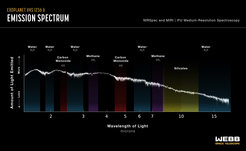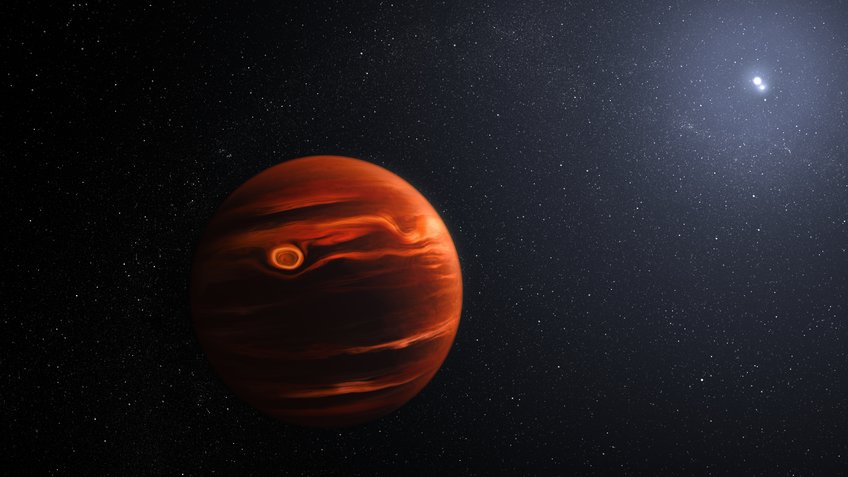Hot sand clouds on a young gas-giant planet orbiting two stars
JWST obtains a direct spectrum of the young exoplanet VHS 1256 b, not relying on transit measurements
An international team of researchers, including MPIA astronomers, employed the James Webb Space Telescope (JWST) to examine the chemistry of the young, hot gas-giant planet VHS 1256 b. They find clouds made of silicate particles, ranging from fine specks to small grains. The team projects that the silicate grains swirling in these clouds periodically get too heavy and rain into the depths of the planet’s atmosphere. JWST’s observations also show clear signatures of water, methane, and carbon monoxide and provide evidence for carbon dioxide.

Researchers observing with the James Webb Space Telescope (JWST) have pinpointed silicate cloud features in a hot and distant planet’s atmosphere. The atmosphere is constantly rising, mixing, and moving during its 22-hour day, bringing hotter material up and pushing colder material down. The resulting brightness changes are so dramatic that it is the most variable planetary-mass object known to date. The team, led by Brittany Miles of the University of Arizona, USA, also made unambiguous detections of water, methane, and carbon monoxide and found evidence of carbon dioxide. This is the largest number of molecules ever identified all at once on a planet outside the Solar System.
Cataloged as VHS 1256 b, the planet is about 40 light-years away and orbits not one but two stars over a 10,000-year period. “VHS 1256 b is about four times farther from its stars than Pluto is from our Sun, which makes it a great target for the JWST,” Miles said. “That means the planet’s light is not mixed with light from its stars.” This circumstance helps the team to investigate the undisturbed emission from the planet’s atmosphere that not only provides detailed information about its composition. The measurements also serve as a template to analyze other planets where the conditions are not so fortunate.
Higher up in its atmosphere, where the silicate clouds are churning, temperatures reach a scorching 830 degrees Celsius (1100 Kelvin). The JWST detected larger and smaller silicate dust grains within those clouds. “The smaller silicate grains in its atmosphere may be more like tiny particles as in smoke,” noted co-author Beth Biller of the University of Edinburgh in Scotland. “The larger grains might be more like very hot, very small sand particles.”
Although VHS 1256 b is more on the heavier side of the known exoplanets, its gravity is relatively low compared to more massive brown dwarfs. Such very low-mass stars can only burn deuterium for a relatively short duration. Consequently, the planet’s silicate clouds can appear and remain higher in its atmosphere, where the JWST can detect them. Another reason its skies are so turbulent is the planet’s age. In astronomical terms, it is pretty young. Only 150 million years have passed since it formed. The planet’s heat stems from the recent formation process – and it will continue to change and cool over billions of years.
In many ways, the team considers these findings the first “coins” pulled out of a spectrum researchers view as a treasure chest of data. They have only begun identifying its contents. “We’ve isolated silicates, but better understanding which grain sizes and shapes match specific types of clouds is going to take a lot of additional work,” Elisabeth Matthews from the Max Planck Institute for Astronomy (MPIA) in Heidelberg, Germany, said. She is a co-author of the study that appears in The Astrophysical Journal Letters today. “This is not the final word on this planet – it is only the beginning of a large-scale modeling effort to understand JWST’s complex data.”
Although all of the features the team observed have been spotted on other planets elsewhere in the Milky Way by other telescopes, astronomers typically identified only one at a time. “No other telescope has identified so many features at once for a single target,” said co-author Paul Mollière (MPIA). “We’re seeing many molecules in a single spectrum from the JWST that detail the planet’s dynamic cloud and weather systems.”

The team came to these conclusions by analyzing data known as spectra. A spectrum is a rainbow-like display of light or, as in this case, e.g., infrared radiation, splitting it into the colors of which it is composed. Two instruments aboard the JWST, the Near-Infrared Spectrograph (NIRSpec) and the Mid-Infrared Instrument (MIRI), gathered those spectra for this investigation. “We are proud to have provided essential technical elements such as filter and grating wheels that select the spectral ranges of such observations,” MPIA director and co-author Thomas Henning says. “Results like these illustrate the fantastic performance of those instruments, and they are bound to revolutionize our knowledge about the cosmos.”
Since the planet revolves around the stars at such a great distance, the researchers could observe it directly rather than using the usual transit technique or a coronagraph.
This work is only the beginning of the team’s research. There will be plenty more to learn about VHS 1256 b in the months and years to come as this team – and others – continue to sift through JWST’s high-resolution infrared data. There is a huge return on a very modest amount of telescope time. With only a few hours of observations, the astronomers have obtained a sheer unending potential for additional discoveries.
What might become of this planet billions of years from now? Since it is so far from its stars, it will become colder over time, and its skies may transition from cloudy to clear.
Background information
MPIA scientists involved in the study are Elisabeth Matthews, Paul Mollière, Thomas Henning, and Matthias Samland.
The researchers observed VHS 1256 b as part of JWST’s Early Release Science program 1386, “High Contrast Imaging of Exoplanets and Exoplanetary Systems with JWST” (PI: Sasha Hinkley), designed to help transform the astronomical community’s ability to characterize planets and the disks where they form.
The James Webb Space Telescope (JWST) is the world’s premier space science observatory. JWST is an international program led by NASA with its partners, ESA (European Space Agency) and the Canadian Space Agency.
This press release is an adaptation of the original version published by the Space Telescope Science Institute (STScI).
MN

